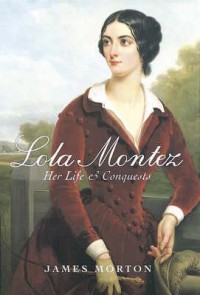Lola Montez: her life and conquests (Morton)

Morton is a professional biographer with a specialty in gangland true crime, so Lola Montez is a little bit out of his wheelhouse, but perhaps not very much so! He gives full credit to Bruce Seymour's fundamental work, based on archival material, from a decade before this was published. I was curious to see how Morton would make the subject his own.
The subtitle gives a bit of a clue: Morton has spread his contextual net quite a bit wider, and that includes giving more biographical detail than Seymour on the various men that passed through Lola's eventful life. In addition, he also picks up historical detail about a place or person from before or after Montez' encounter with them: for instance, we get a few pages on the subject of Jane Digby, the English adventuress who preceded Lola in Ludwig I's affections. We also get a bit more illustrative detail on social and physical conditions in Californian and Australian gold country. The last chapter is a follow-up on the fate of Lola's supporting cast, plus a survey of Montez in popular culture (novels, theatre, film, even ballet) after her death, which I found an interesting and useful addition. He recommends "The Heavenly Sinner" by Thomas Everett Harré as probably the best novelization.
The second way I'd say Morton distinguishes himself from Seymour is in his very extensive use of contemporary newspapers, a source he's probably extremely comfortable in because of his true crime specialty. So we get a good feel of how the average English-speaking newspaper-reader saw Lola over the course of her life (and from her obituaries), since he has clearly tracked pretty much every reference to her in all the English-language papers in Britain, the U.S. and Australia. I suspect he did not feel similarly comfortable in the other European languages.
Finally, Morton's narrative tone is quite a bit more spritely than Seymour's. I can't imagine the latter writing, "Throughout her life Lola appears to have believed men's hearts were situated somewhere below the fourth waistcoat button." He's not above inserting an adjective or adverb into an otherwise bald statement of fact to support a cynical reading of the situation. While by no means in the same league of trashiness of some of the modern celebrity biographies I've read - Morton gives us notes, bibliography, and index, and a highly restrained use of the exclamation mark - this work is in tone aimed far more at the casual reader. (That, by the way, is not any sort of criticism of Seymour's prose, which I found highly readable also).
While I'm not sorry to have read the two different and well-researched takes on Lola Montez' bizarre life, that's about enough Lola for me now.



